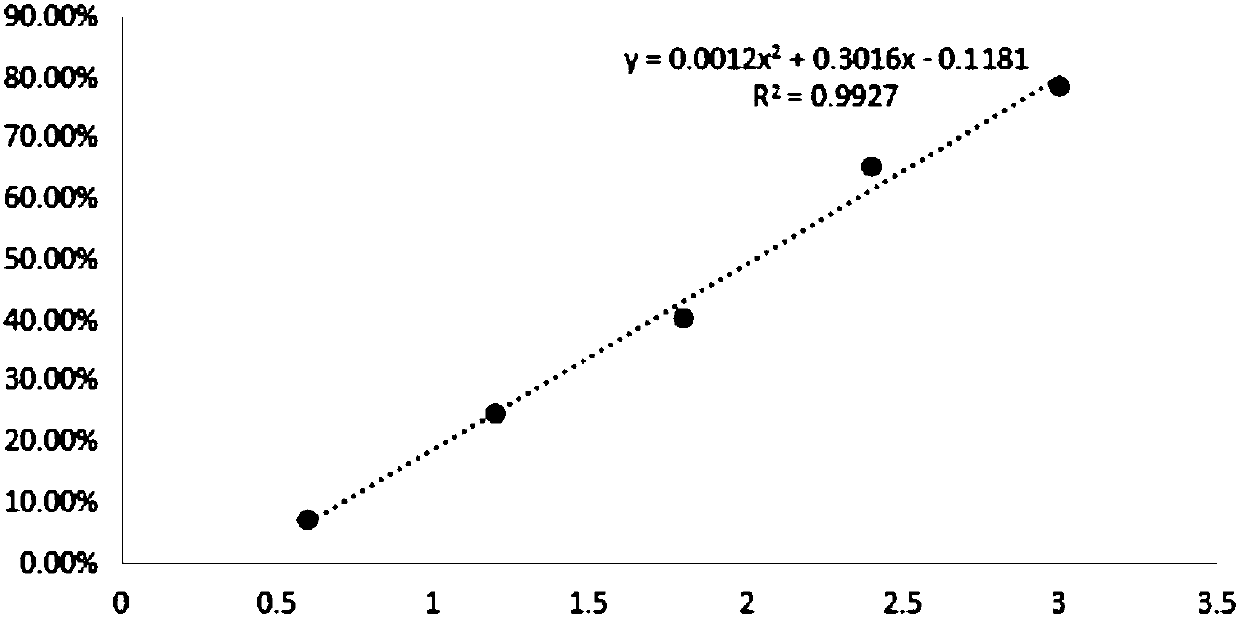Composition as well as application and health care product thereof
A composition and technology of mulberry leaf juice, applied in the field of biomedicine and health care products, can solve problems such as uneven quality and rare health food, and achieve the effects of controlling blood sugar, preventing diabetic complications, and preventing degenerative changes
- Summary
- Abstract
- Description
- Claims
- Application Information
AI Technical Summary
Problems solved by technology
Method used
Image
Examples
Embodiment 1~3
[0041] Embodiment 1~3 composition of the present invention
[0042] Weigh the mulberry leaves, add water 40 times the weight of the mulberry leaves, extract at a constant temperature of 50°C for 2.5 hours, filter, and take the juice to obtain mulberry leaf juice.
[0043] Take guava leaves and weigh them, add water 40 times the weight of guava leaves, extract at a constant temperature of 90°C for 2 hours, filter, and take the juice to obtain guava leaf juice.
[0044] Take stevia and weigh it, add water 15 times the weight of stevia, extract at a constant temperature of 60°C for 2 hours, filter, and take the juice to obtain stevia juice.
[0045] Weigh the licorice slices, add boiling water 20 times the weight of the licorice slices, heat and extract for 2 hours on low heat, filter, and take the juice to obtain licorice juice.
[0046] Composition of the present invention, raw material composition is as shown in table 1:
[0047] Table 1 Example 1-3
[0048]
Embodiment 4
[0064] Embodiment 4 sensory evaluation experiment
[0065] Table 2 Sensory scoring criteria
[0066]
[0067] 15 professionals used the 100-point scoring method in the sensory test to comprehensively evaluate the mulberry leaf guava leaf tea beverage. Considering that the target audience of this beverage is mainly diabetics, and in order to draw a more rigorous conclusion, the During the sensory evaluation, 60% of the 15 people participating in the sensory evaluation were diabetics, that is, 9 people were diabetics. Evaluation items include the color, smell, taste and state of the product.
[0068] According to the sensory evaluation criteria in Table 2, the tea beverages prepared in Examples 1-3 and Comparative Examples 1-7 of the present invention were evaluated, and the results are shown in Table 3.
[0069] Table 3 Sensory evaluation results
[0070]
[0071]
[0072] As can be seen from Table 3, the total scores of the tea beverages described in Comparative Ex...
Embodiment 5
[0073] Embodiment 5 DPPH free radical scavenging rate experiment
[0074] The antioxidant capacity of the tea drinks of Examples 1-3 and Comparative Examples 1-7 was measured by the DPPH method.
[0075] According to the DPPH free radical has a single electron, there is a strong absorption at 517nm, and its alcohol solution is purple. When there is a free radical scavenger, its absorption gradually disappears due to pairing with its single electron, and its fading degree has a quantitative relationship with the number of electrons it accepts, so a spectrophotometer can be used for rapid quantitative analysis. When measuring the antioxidant capacity of active substances by spectrophotometry, the mass concentration IC50 value when the clearance rate reaches 50% is the quantitative evaluation index for the antioxidant capacity of active substances. The smaller the IC50 value, the stronger its antioxidant activity.
[0076] 1. Configure the solution
[0077] (1) Prepare 0.25g / m...
PUM
 Login to View More
Login to View More Abstract
Description
Claims
Application Information
 Login to View More
Login to View More - R&D
- Intellectual Property
- Life Sciences
- Materials
- Tech Scout
- Unparalleled Data Quality
- Higher Quality Content
- 60% Fewer Hallucinations
Browse by: Latest US Patents, China's latest patents, Technical Efficacy Thesaurus, Application Domain, Technology Topic, Popular Technical Reports.
© 2025 PatSnap. All rights reserved.Legal|Privacy policy|Modern Slavery Act Transparency Statement|Sitemap|About US| Contact US: help@patsnap.com



